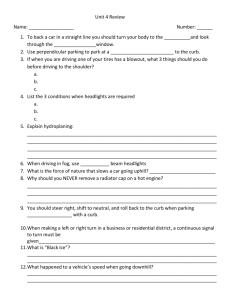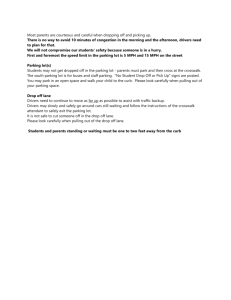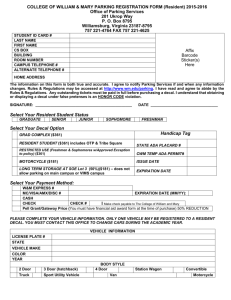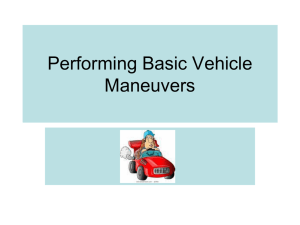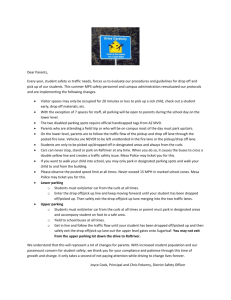Module 4teacherworkbookanswers
advertisement
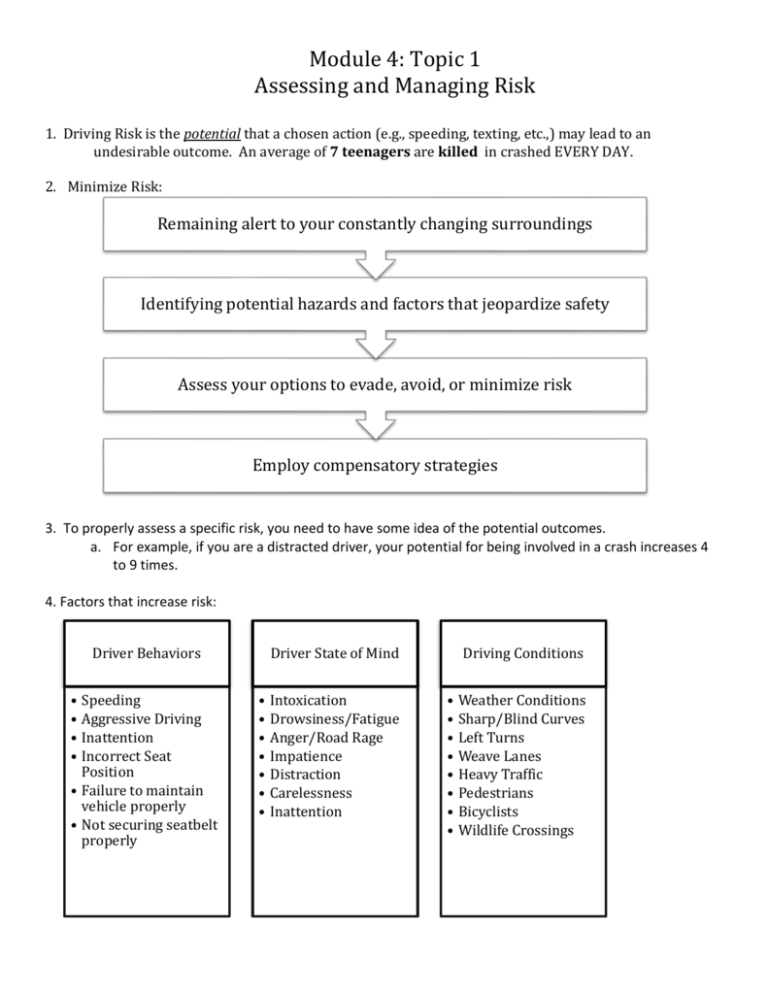
Module 4: Topic 1 Assessing and Managing Risk 1. Driving Risk is the potential that a chosen action (e.g., speeding, texting, etc.,) may lead to an undesirable outcome. An average of 7 teenagers are killed in crashed EVERY DAY. 2. Minimize Risk: Remaining alert to your constantly changing surroundings Identifying potential hazards and factors that jeopardize safety Assess your options to evade, avoid, or minimize risk Employ compensatory strategies 3. To properly assess a specific risk, you need to have some idea of the potential outcomes. a. For example, if you are a distracted driver, your potential for being involved in a crash increases 4 to 9 times. 4. Factors that increase risk: Driver Behaviors • • • • Speeding Aggressive Driving Inattention Incorrect Seat Position • Failure to maintain vehicle properly • Not securing seatbelt properly Driver State of Mind • • • • • • • Intoxication Drowsiness/Fatigue Anger/Road Rage Impatience Distraction Carelessness Inattention Driving Conditions • • • • • • • • Weather Conditions Sharp/Blind Curves Left Turns Weave Lanes Heavy Traffic Pedestrians Bicyclists Wildlife Crossings 5. Actions have consequences: a. Taking unnecessary risks may result in property damage, injury or death, and other losses b. Injury to you or others - permanent or life-threatening, c. Damage to personal property, and d. Loss such as financial loss, loss of license, loss of convenience, loss of time, and other losses. 6. Driver actions that cause crashes in Virginia: a. Speeding - #1 b. Failure to yield the right of way - #2 c. Driving while intoxicated - #3 d. Disregarding a traffic sign or signal -#4 e. Following too closely - #5 f. Improper turns g. Unsafe passing 7. Other factors that increase risk: a. Worn or bald tires, poorly adjusted and/or worn brakes, broken headlights, worn windshield wiper blades, dirty windshield b. Road Design c. Weather conditions d. Road surface – wet, snow, ice, gravel 8. How can you reduce your risk? Signal • brake light (flash, slowing, stopping) • lane position (intent to change lanes or turn, hazard in lane ahead) • horn (warn, get someone’s attention) Change Speed • Your options are to maintain, increase or decrease speed Change Postion or Direction • It is quicker to change position than to stop, so you always need to know what space is available to: • move to a different lane position to gain more space • change lanes • turn onto another street Module 4: Topic 2 Components of the Space Management System 1. Drivers use SEEiT to reduce risks: a. Drivers need visibility, space, and time to avoid conflicts and perform safe driving maneuvers b. Good seeing habits and the ability to manage space on the roadway are essential ingredients for low-risk driving c. Developing space management HABITS can reduce driving risks S E E Evaluate Execute i T in Time Search Look for potential hazards Seaerch at least 20-30 seconds ahead What do you need to do to avoid a collision? Carry out your plan What are some things you would be searching for? 2. Space around your vehicle: a. Drivers must manage all six zones around the vehicle, and adjust position to maintain a safe margin of space that provides room to steer in an emergency 3. A Zone can be Open, Closed or Changing a. OPEN — An open zone is a space where you can drive without restriction b. CLOSED — The space or area is not available in the vehicle’s path of travel c. CHANGING — An open zone changes to a closed zone or a closed zone becomes an open zone Think about a traffic light: A RED light would be a CLOSED zone. A YELLOW light would be a CHANGING zone. A GREEN light would be an OPEN zone. 4. Use the diagram below to answer questions below. You are in the solid colored vehicle. ---------------------------------------------------------------------------------------------------------------------- Which area is an open zone? a. left lane b. right lane c. rear of the vehicle d. none of these area are open What area is closed? a. left lane b. front of the vehicle c. right lane d. none of these area are closed 5. Following Intervals: a. Drivers have the most control over the space directly in front of the vehicle b. 2-Second - Following Distance is effective at speeds under 35 mph c. 3-Second - Following Distance may provide enough time for evasive steering maneuver on dry surfaces or to brake at speeds up to 45 mph d. 4-Second - Following Distance provides time to steer out of a problem on dry surfaces and brake out of a problem at speeds up to 70 mph Measuring Your Following Distance 5-6 SECONDS 7-8 SECONDS 7-8 SECONDS Traffic is moving at 30 MPH to cross a two lane roadway (vehicles need to be at least a block away) to cross a four lane intersection to turn left (vehicles need to be more than a block away or length of a football field. 6-7 SECONDS to turn right (vehicles need to be at least a block away) 4-6 SECONDS to change lanes into traffic from parked position 6. When should you increase your following distance? a. Visibility is limited b. Traction is limited c. Number of visual and mental tasks increases d. Being tailgated e. Line of sight restriction f. Path of travel restriction g. Carrying a heavy load or pulling a trailer h. Learning to drive 7. When stopping behind a vehicle you should see the REAR tires on the pavement of the car in front of you. 8. Manage your space to the rear: a. Regularly b. Before and while braking c. While stopped in traffic d. Before and after making turns e. Before and after a lane change Can you control the space behind you? 9. Manage the space to the side: a. Strive to keep one of the side zones open b. Respond to an oncoming vehicle by slightly adjusting lane position to increase space between your vehicle and the oncoming vehicle c. Adjust lane position to increase space between your vehicle and parked cars, bicyclists, pedestrians, etc. 10. Judging Gaps: In order to judge a gap you need to be able to judge speed, time and distance while moving. 11. Reaction Time Perception Time a. Time it takes to identify a risk b. Average perception time varies with the circumstances Time it takes to respond with accelerator, brake, or steering b. Average reaction time is ¾ second a. Response Time a. Total time it takes to complete the action 12. What are some factors that affect reaction time? 13. Calculating Speed and distance: a. Formula to calculate feet per second for each MPH of speed b. A vehicle will travel 1.467 (rounded up to 1.5) feet per second for each mph of speed 40 mph x 1.5 = 60 feet per second 60 mph x 1.5 = 90 feet per second 80 mph x 1.5 = 120 feet per second 14. Simplified formula to calculate feet per second for each MPH of speed: a. Take the speed, divide by two, and add the answer to the speed. Examples: 40 mph ÷ 2 = 20 + 40 = 60 feet per second 60 mph ÷ 2 = 30 + 60 = 90 feet per second 80 mph ÷ 2 = 40 + 80 = 120 feet per second Why is it important to understand the formulas above? Module 4: Topic 3 Using the SEEiT Space Management System 1. Search: a. Know when, where and what to look for b. Search far ahead, to the sides, to the rear c. Search for clues: intersections, brake lights, warning signs, traffic lights, other vehicles, pedestrians, animals, parked cars, etc., d. Search for changes in front wheels of other vehicles, movement from the side, etc. e. Search intersections, crosswalks, shopping centers, parking lots, construction areas and playgrounds f. When driving in rural areas search for hidden intersections and driveways, curves, hills and varying road conditions g. Search for trucks and other oversized vehicles, as well as slow moving farm vehicles, motorcycles, bicycles, etc. 2. Evaluate: a. Gives meaning to your search b. Identifies where the possible points of conflict may occur c. Determines how the conflict may affect you if it does happen 3. What will you evaluate? Some Examples: a. Is the traffic light a stale green light? b. Will the zone I’m entering be open or closed? c. What lane position is the safest? d. What is the other driver going to do? e. Is the driver texting? f. Is there more than one way to manage this risk? g. Where will the point of conflict occur? h. Where is the escape route? i. Will someone run the light? j. Will a pedestrian enter the roadway? k. Is there sufficient traction available? l. Is the driver in the vehicle behind me paying attention? m. Will a door of one of these parked cars open? n. Will a squirrel or deer run onto the road? 4. When you execute, you have made a decision on how to handle the conflict and you carry out your plan IN TIME! 5. Without proper searching, evaluating (decision making skills), you may execute the wrong decision Module 4: Topic 4 Moving the Vehicle 1. Once you have completed your pre drive check you are ready to start the car and move into traffic: a. Start the engine with right foot on brake b. Check instrument panel c. Adjust accessories (HVAC/sound system, etc.) d. Select proper gear e. Release parking brake f. Signal g. Check traffic 2. Moving straight forward: a. With right foot on brake and hands at 8 o’clock and 4 o’clock b. Select Drive gear c. Select a target d. Recheck traffic e. Take foot off brake (do not accelerate) f. Straighten wheels if necessary g. Move straight towards target h. Accelerate slowly i. Brake as you approach the target 3. Backing: a. Many new drivers’ first “fender bender” is a backing collision! b. Make proper adjustments c. Start the vehicle with foot on the brake d. Shift to reverse e. Assume the straight backing position f. Left hand at 12 o’clock g. Looking over right shoulder h. Check traffic to front, sides and rear i. Select a target j. Gradually release brake pressure k. Move slowly l. Accelerate gradually m. Cover the brake when needed 4. Backing and Turning: a. Signal b. Readjust seat position according to direction that you turn wheel - Right Side/Left Side c. Establish visual target d. Use reference points to determine when to start turning steering wheel e. Turn the wheel in the direction you want the back of the vehicle to go f. Monitor “swing” in front of the vehicle 5. Entering the Roadway: a. Review pre-drive tasks b. Start the vehicle c. Shift to drive d. Release parking brake e. Check traffic and signal f. Move to first available lane g. Targeting center of lane – lane position 1 h. Cancel Signal 6. Moving to the curb/side of the road: a. Check traffic b. Signal intentions c. Visually target destination d. Use reference points to position vehicle 6 – 12 inches from curb e. Secure the vehicle Module 4: Topic 5 Turnabouts and Parking 1. Why do you use a turnabout? a. If you miss an address or building and you do not have the option of driving around the block 2. Types of Turnabouts: a. Two-point turn: Pull into driveway on right side Pull into driveway on left side b. Three-point turn c. U-turn Midblock At an intersection 3. Minimize risk for a turnabout: a. Being sure local laws permit a turnabout — look for any signs prohibiting the turn b. Making sure you have at least 500 feet of visibility in each direction c. Being sure you have enough space and time to complete the turn safely d. Never making a turnabout near or on hills and curves e. Checking continually for other traffic and pedestrians — check all zones around your vehicle 4. Two-Point Turnabout: Backing into driveway on the right side: a. Check traffic flow b. Signal, and position yourself 2-3 feet from curb c. Drive beyond the driveway and stop d. Shift to reverse, monitor intended path e. Back slowly, turning steering wheel rapidly to the right as you enter driveway f. Straighten wheels, centering car in driveway and stop with the wheels straight g. Signal left and exit driveway when the way is clear 5. Two-Point Turnabout: Pulling into driveway on the left side: a. Check traffic flow b. Signal and position your vehicle to 3-6 inches from center yellow line c. When traffic is clear, drive into the driveway and stop d. Shift to reverse, monitor intended path e. Back slowly, turning steering wheel rapidly to the right as you exit driveway f. Straighten wheels, centering car in roadway g. Shift into drive - Check traffic and accelerate to normal speed 6. Three Point Turnabouts: a. Three-point turns are also called Y-turns, and are an option if no driveway is available, traffic is light, you cannot drive around the block, or the available space prevents a U-turn b. This is the most dangerous turnabout! These steps match the diagram below: #1. Stop close to the right edge or curb Search for a 20- to 30-second gap, signal a left turn #2 Move slowly forward while turning the steering wheel rapidly to the left When the front wheels are almost to the curb, stop — Check traffic left and right# #3. Shift the vehicle into reverse and, while slowly backing up, turn the wheel to the right #4. Shift into drive Check traffic Signal your intent and accelerate to normal speed 7. Mid-Block U-Turn: a. Make sure local and state law permits this type of turnabout b. A midblock U-turns require a wide space c. This is a high-risk turnabout 8. U-Turn at an Intersection: a. When making a U-turn at an intersection, begin the U-turn in the left lane closest the center line or median b. Complete the turn in the lane farthest to the right in the opposite flow of traffic, and accelerate to the appropriate speed c. Why is the U-turn a high risk turnabout? 9. Parking Strategies: a. Look for a parking space with enough room for entering and exiting easily b. Observe and follow all signs, laws, pavement markings c. Look for vehicles exiting parking spaces d. Avoid spaces at the end of parking lanes where being hit is more likely e. Avoid spaces near a large vehicle that block your vision when existing and other people’s ability to see you f. Avoid spaces with a poorly parked vehicle on either side 10. Parking is NOT allowed: *these appear on the knowledge part of the permit test very often a. Beside another parked vehicle (double parking) b. On crosswalks or sidewalks c. In front of driveways d. Next to painted yellow curbs or no parking signs e. In a parking space reserved for disabled persons f. On the hard surface of a road when no curb is present g. Within 20 feet of an intersection h. Within 15 feet of the entrance to a fire, ambulance or Rescue squad station i. Within 500 feet of where fire trucks or equipment are stopped answering an alarm j. Within 50 feet of a railroad crossing k. Within 15 feet of a fire hydrant 11. Angle Parking: a. Signal intention, position vehicle three to four feet away from the space b. Move forward until side view mirror appears to align with the first pavement line c. Visually target the middle of the space and move slowly turning the wheel sharply d. Once front enters space, gradually begin unwinding the steering wheel while monitoring the vehicles parked on either side 12. Exiting an Angle Space: a. Place foot on brake, signal intention, shift to reverse, search path of travel b. Back until your vehicle’s front seat is even with the back of the space, and begin turning the steering wheel in the direction you want the rear to go c. Constantly monitor the front bumper on the opposite side of the direction you are turning d. Back into the closest lane; shift to drive and move forward 13. Perpendicular Parking: Entering a Parking Space: a. Signal intention and position the vehicle five to six feet away from the space b. Move forward until the side view mirror appears to align with the first line of the space c. Turn the wheel rapidly in the direction of the space controlling speed d. Steer towards a target in center of the space and straighten the wheels e. Position the front bumper three to six inches from the curb or end of the space 14. Perpendicular Parking: Exiting: a. Place foot on brake, signal direction of turn, shift to reverse, search area to the rear/sides b. Back until your side view mirror is even with the bumper of the vehicle located to the side, begin turning the steering wheel in the direction you want to go c. Monitor the rear and your front bumper on the opposite side of the direction you are turning d. When the front bumper clears the back of the vehicle, stop, and shift to drive 15. Parallel Parking on a Two-Way Street STEP 1 a. Select a space that is at least five feet longer than your vehicle b. Flash your brake lights, put on your turn signal as you approach the space, and monitor rear traffic c. Place your vehicle approximately three feet from the vehicle you want to park behind, aligning your rear bumper with the other vehicle's rear bumper d. Put the vehicle into reverse and turn the wheels all the way to the right STEP 2 a. Slowly back up until you are at a 45-degree angle using your side view mirror b. Back until you can see the headlight closest to the curb of the vehicle behind to establish the 45-degree angle c. Stop STEP 3 a. Turn the wheels all the way to the left b. Slowly back up monitoring the right front fender until you are parallel with and within 12 inches of the curb. 16. Parallel Parking – Exiting the Space: a. Back-up as far as you can go without touching the vehicle behind and signal b. Turn your wheels all the way to the left and shift to Drive c. Check traffic and make sure your right front fender will clear the rear of the vehicle in front of you d. Turn wheels slowly to the right when your side view mirror aligns with the bumper of the vehicle ahead e. Select target in your path of travel and gently accelerate 17. Parking on a Hill – Facing Downhill a. Parking with or without a curb b. Position your vehicle 6” from the curb c. Let the car move slowly forward while turning the steering wheel sharply to the right until the right front tire rests against the curb d. Shift into “P” (Park) if your vehicle is equipped with an automatic transmission or into REVERSE gear for a manual transmission Downhill Parking 18. Parking on a Hill – Uphill with No Curb: a. Drive as far off the roadway onto the shoulder as possible and stop b. Turn wheels away from traffic c. Shift into “P” (Park) automatic transmission, or into FIRST gear for a manual transmission d. Engage the parking brake Parking Uphill with NO Curb 19. Parking on a Hill – Uphill With a Curb: a. Position your vehicle 6” from the curb and stop b. Turn your steering wheel away from curb and let the vehicle move slowly back until the back of the front tire touches the curb c. Shift into “P” (Park) if your vehicle is equipped with an automatic transmission or FIRST with a manual transmission d. Engage the parking brake Uphill Parking With a Curb 20. Parking Lot Strategies: a. Obey speed limits b. Obey the signs and pavement markings c. Do not drive diagonally across parking lot lane markings d. Be alert for pedestrians, bicyclists, roller-bladders and skateboarders e. Avoid tight parking spaces f. Avoid competing for a parking space g. Park so the front and rear of vehicle is not in the flow of traffic h. Position the vehicle properly in the space i. Secure parking brake j. Secure the vehicle, locking valuables in the trunk k. Search all directions before exiting the parking space l. Watch for drivers backing who may not see vehicles to the rear 21. Parking Garage Strategies: a. Watch for backup lights b. Observe and follow all signs c. Stay to the right d. Use headlights e. Be aware of people in and around the garage f. When entering the parking garage, be aware of your surroundings, approach the vehicle with key in hand, look around and in the vehicle for unwanted passengers g. Drive slowly and watch for pedestrians 22. Handicapped Parking: a. Vehicles displaying this symbol on their license plate or in the car on a special card may park in handicapped spaces b. Non-handicapped drivers are prohibited from parking in handicapped parking areas and may be fined ($100 +) for violations c. A disabled person will be fined $500.00 if he/she lets someone use his/her parking placard and can have parking privileges revoked.
